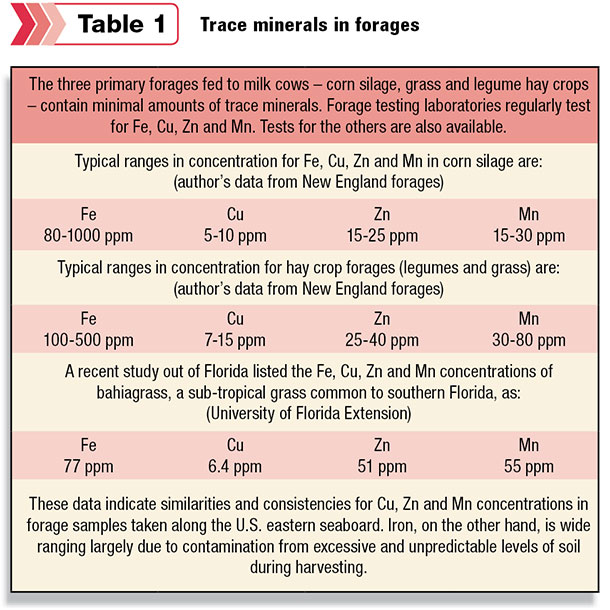Trace minerals are those minerals required by dairy cattle and youngstock in very small amounts – usually at the milligram level per day. The occurrence of trace minerals in forages is largely dependent on the amount of those minerals found in the soil in which the forage is grown.
Nine trace minerals are considered essential for dairy cows. They are:
- Iron (Fe)
- Zinc (Zn)
- Copper (Cu)
- Manganese (Mn)
- Selenium (Se)
- Cobalt (Co)
- Molybdenum (Mo)
- Iodine (I)
- Chromium (Cr)

Iron
According to Bill Weiss from Ohio State University, all basal diets contain enough iron, and it’s unlikely that dairy cattle will be deficient in iron. Testing for Fe in forages is worthwhile, however, as it can give us an indication of excessive contamination of soil in those forages.
A forage sample with a high level of Fe indicates a lot of soil was picked up during the harvesting process. Excessive levels of Fe, while not toxic, can be antagonistic to the absorption of other minerals and will add to the total ash value of a forage analysis, possibly resulting in the skewing of energy and digestibility values.
Copper
Copper is found in very low levels in all forages. Copper is necessary for a number of body functions and disease resistance as well as being an essential constituent of blood.
The 2001 NRC recommendation for copper in dairy cow diets is 13 to 15 parts per million (ppm). All forages (along with most commodities) fall short of adequate Cu, which means Cu should be routinely supplemented in milk cow and youngstock diets.
Copper sulfate has been the copper source of choice for many years. There are also chelated (organic) forms of copper available.
Zinc
According to the 2001 NRC, milk cows require 40 to 45 ppm of zinc per day. Forages for the most part will fall on the low side of that requirement. Zinc sulfate is commonly added to diets. The addition of the metal-amino acid complex (zinc-methionine) has been popular for many years in both aiding the immune system as well as improving hoof health.
Manganese
Manganese has been identified as being necessary for immunity, reproduction and digestion. Studies on manganese requirements are not definitive, but the 2001 NRC recommendation for manganese is currently 30 to 50 ppm per day.
Forages usually test high enough in Mn so as to not require any additional supplementation. Research does not indicate that a deficiency in Mn leads to any immediate diseases or metabolic challenges. Organic forms of manganese are available for supplementation in dairy cow diets.
Selenium
Selenium concentrations in forages are highly variable throughout the country. Samples can test as low as zero ppm to nearly 1 ppm. However, the vast majority tend to be less than 0.5 ppm.
Selenium deficiency in livestock has been identified as a contributor to white muscle disease. Selenium, working in conjunction with vitamin E, supports immune function. Selenium toxicity has been linked to neurological disorders and blindness.
Research has determined there is a very narrow range between safe and toxic levels of Se. Selenium is the only trace mineral regulated by the FDA. Dairy diets with more than 0.3 ppm supplemental Se are illegal. Selenium should be carefully supplemented only in those regions of the country where soils and forages are identified as being less than 0.1 ppm. Organic forms of Se are widely available.
Molybdenum
Molybdenum is well-known to be antagonistic to copper uptake and absorption. Excessive Mo in dairy diets will cause a copper deficiency. In the presence of high Mo, copper deficiencies will occur even when Cu is being supplemented at recommended levels.
Forages testing over 5 ppm have been found to prevent copper from being properly metabolized. Molybdenum levels in forages vary widely and are most likely to be elevated in the more alkaline soils. According to the 2001 NRC, several enzymes found on milk and tissue contain Mo, making it an essential trace mineral. However, deficiencies of Mo have not been reported, and supplementation is not suggested.
Cobalt
In recent years, more emphasis has been placed on supplementing cobalt levels to bolster vitamin B12 production in the rumen. B12 is a precursor to propionic acid production in the rumen which, in turn, is a precursor for glucose production. B12 is also necessary for the synthesis of red blood cells, hormones, proteins and fatty acids.
There is only limited data on cobalt in forages reporting that average values in pasture grass are around 0.1 ppm. Studies after 2000 recommend that cows should receive between 0.15 to 0.20 ppm of Co per day, indicating that cobalt should be supplemented in dairy cow diets.
Chromium
According to Weiss, the best-understood metabolic function of chromium is as a component of the glucose-tolerance factor, which enhances the action of insulin. However, immune function and health data are too inconsistent to estimate a requirement for chromium in dairy cattle.
Research suggests that basal diets contain adequate chromium to meet normal metabolic needs. However, chromium supplements are available and supplementation can be beneficial during fresh cow transition and early lactation when energy requirements are high.
Iodine
According to the 2001 NRC, iodine is necessary for the synthesis of the thyroid hormones that regulate energy metabolism. Iodine levels in forages are extremely variable and are dependent on the iodine content of the soil. Soil near the ocean tends to supply adequate iodine in forages.
In many inland areas of the country, iodine in forages is generally low enough to result in iodine deficiencies. Iodine is easily supplemented in dairy diets, with ethylenediamine dihydriodide being the most common.
While the complete function of several of the trace minerals are still poorly understood, it is widely accepted that the essential trace minerals are critical for overall health, disease resistance and proper enzyme synthesis as well as metabolic functions such as muscle and bone development, digestion, reproduction and milk production.
Organic versions of several of the trace minerals (chelates and metal-amino acid complexes) having increased bioavailability are now being marketed. Improved bioavailability has the potential to increase profitability on dairies while reducing the environmental impact of wasting minerals.
As more emphasis is being placed on high-forage diets for dairy cows, it has become necessary to re-evaluate the trace mineral levels in dairy cow and youngstock diets, making certain that trace mineral nutrition is not deficient in those diets. PD

-
John Hibma
- Consulting Ruminant Nutritionist
- Connecticut
- Email John Hibma







